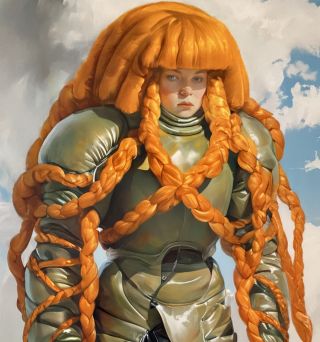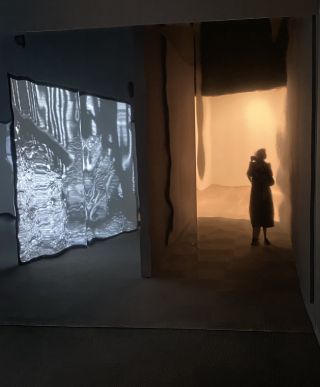Artificial Intelligence
A Collector's Dilemma: AI or Human Art?
Can AI replace human creativity in the arts?
Updated April 27, 2024 Reviewed by Pam Dailey
Key points
- Two studies showed a viewers' preference for works labeled as human-created but actually AI-generated.
- People appear to place greater value on art that is created out of human experience.

Art created by artificial intelligence (AI) is currently featured at the 2024 Whitney Museum of American Art Biennial in New York City. The exhibition, “Even Better Than the Real Thing” (March 20 through August 11), showcases AI in its first display and later in the exhibit. More AI-produced work is exhibited in the museum, but not part of the Biennial.
Any art featured at the Biennial is, by definition, new and cutting-edge. The committee’s choice of featuring AI puts AI where it belongs—new, exciting, novel, and, for many, uncertain. This is because the rapid advancements in AI have sparked a debate about whether it can replace human creativity in the arts. Critics argue that the essence of human creativity is irreplaceable by machines, emphasizing the importance of human experience in artistic creation.
The Research

Recently, this conundrum has been studied scientifically by Lucas Bellaiche and colleagues (July 2023). Their paper is titled “Humans versus AI: Whether and Why We Prefer Human-Created Compared to AI-Created Artwork.” Bellaiche and colleagues explored whether there is a preference for human-created over AI-created art and the underlying reasons for such preferences.
The research comprised two studies involving participants who evaluated artworks that, unbeknownst to them, were all created by AI. These artworks were randomly labeled either as "human-created" or "AI-created" to assess the impact of labels on the participants' aesthetic judgment. The evaluation criteria included liking, beauty, profundity, and worth.
The results from the first study indicated that artworks labeled as human-created were consistently rated higher across all criteria than those labeled as AI-created, thus indicating a bias towards human-created art. To further explore this bias, the second study expanded the evaluation criteria to include emotional response, story perception, perceived meaningfulness, effort, and estimated time taken to create the artwork.
The second study's findings confirmed the initial results, with human-labeled artworks again receiving higher ratings. However, the second study also revealed that the narrative associated with the artwork and the perceived effort behind it significantly influenced ratings. Specifically, artworks that were thought to involve more human effort or conveyed a compelling story were rated higher in terms of liking and beauty. Moreover, participants' attitudes towards AI also affected their judgments, with more positive attitudes towards AI leading to higher ratings for AI-created art, particularly regarding profundity and worth.
These studies demonstrate a clear bias against AI-created artworks compared to those believed to be made by humans, particularly for judgments beyond surface-level aesthetic appreciation. This bias is less pronounced in sensory-level judgments, such as liking and beauty, where AI-created artworks can compete closely with human-created ones.
To say this differently, the studies suggest that while AI can produce aesthetically pleasing art at the sensory level, it struggles to replicate the deeper communicative aspects of art enriched by human experience. This distinction between sensory and communicative judgments aligns with dual-process theories in aesthetics, which differentiate between artworks' immediate, sensory processing and the more reflective, meaning-oriented evaluation.
In addition, the work of Bellaiche and colleagues highlights how different factors, such as narrative and perceived effort, can modulate the impact of the creator label on aesthetic judgments. For instance, when an artwork is perceived to have a rich narrative or to require significant effort, it is more likely to be appreciated, regardless of whether it is human- or AI-created. However, these effects are influenced by the viewers' attitudes towards AI, suggesting that as societal attitudes evolve, so too might perceptions of AI-created art.
Thus, AI can mimic certain aspects of human artistic creativity, particularly in producing visually appealing artwork. It is less successful at replicating the human-centric elements that contribute to the profoundness and value of art.
The Future
The implications of this research are significant for understanding the future of art in the age of AI. As AI technologies continue to develop and become more integrated into the creative industries, it will be important to consider how they are perceived and the roles they are suited to fill. While AI might not replace human artists, it could potentially serve as a tool that complements human creativity, enhancing the artistic process rather than supplanting it.
Conclusion
This study contributes to the ongoing discourse on the relationship between AI and human creativity. It underscores the enduring value of human touch in art, which encompasses more than just the production of aesthetically pleasing objects but also involves the communication of profound human experiences and emotions.
References
Bellaiche, L., Shahi, R., Turpin, M. H., Ragnhildstveit, A., Sprockett, S., Barr, N., Christensen, A., & Seli, P. (2023). Humans versus AI: Whether and why we prefer human-created compared to AI-created artwork. Cognitive Research: Principles and Implications, 8(1), 1-22. https://doi.org/10.1186/s41235-023-00499-6




